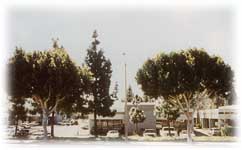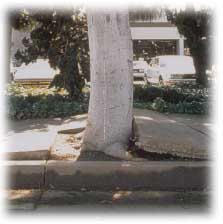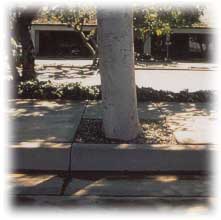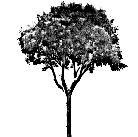
|
||
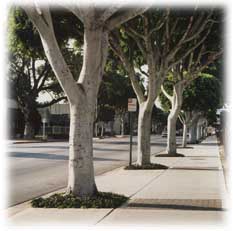 |
||
| In every town and city buckled sidewalks, cracked driveways
and roadways, uprooted paths and even damaged home foundations and patios
are the result of conflict between hardscapes and tree roots. For 20 years
DeepRoot tree root barriers have been providing the solution to these problems.
DeepRoot is a mechanical barrier that redirects root growth downward, eliminating
the surface rooting that damages expensive hardscapes and creates a hazard.
Used both in new tree planting and root pruning applications (like the
photo above, see Notable Project section for details) to save the value
and beauty of mature trees, DeepRoot is an important tool in the elimination
of this costly problem.
Our web site contains all the information Landscape Architects, Municipal Specifiers, Engineers, Contractors, Developers and Homeowners need to use DeepRoot. |
||
|
||
| The tree on the right was planted using DeepRoot while the tree on the left was planted without DeepRoot. They are of similar height and span but the tree without DeepRoot has caused major upheaval while the sidewalk surrounding the DeepRoot tree is smooth and intact. For a closer look check out these photos from the same block. | ||
|
||
| The Ficus Nitida on the right was planted with DeepRoot
while the tree on the left was not and has caused considerable damage and
created a pedestrian hazard. Cities and property owners are liable for
damage and injury caused by uprooted hardscapes.
The cost of these repairs to cities is staggering. A recent sidewalk survey of residential and collector streets in San Jose, California, found 2,274,400 square feet of sidewalk damage with an estimated repair cost of $14.3 million. (Watson, G.W. and D. Neely. (eds.) 1995. pp. 49-63. Trees & Building Sites. International Society of Arboriculture, Savoy, IL.) Exactly how does DeepRoot work? DeepRoot takes advantage of the natural growth habits of roots. Tree roots are opportunistic meaning they will grow wherever adequate conditions exist that supply oxygen, water and other nutrients. As a root tip travels out from the root ball the tip will come in contact with the barrier. Unable to penetrate through the barrier the root will turn and eventually come in contact with the vertical 90° ribs that are spaced every six inches. The root tip then travels along the length of the rib before finally exiting underneath the barrier. This process of guiding the root down and then out from underneath the barrier enables the tree to grow to its full potential while eliminating the surface rooting and buttress root effect that damages hardscapes and utilities. This growth pattern is demonstrated in the photo illustration below: |
||
|
||
| Another example of the downward growth pattern DeepRoot creates is from this photo of a recent test by the United States Department of Agriculture, Forest Service at the Western Center for Urban Forest Research in Solano, California. This test involved trees planted with DeepRoot and control trees planted with no barrier. | ||
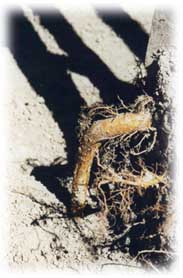 |
||
| As you can see the root has been deflected downward by the 90º rib. In contrast the roots of the control tree below are growing horizontally at or near grade level. | ||
 |
||
| Where the root travels once it is underneath the barrier is determined by many factors including soil compaction, drainage and soil type. Some roots may begin to return to the surface, however the capacity of those roots to cause damage is negated. A root that has traveled down the length of the barrier and exited underneath has passed what is known as the Zone of Rapid Taper (ZRT) This area causes most hardscape damage. The ZRT is the buttress root effect where surface roots close to the trunk swell as they age. This photo illustrates damage caused by buttress roots. | ||
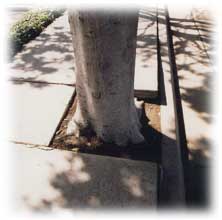 |
||
| By contrast the DeepRoot tree diverts this buttress growth
below grade thereby preventing damage.
Planting trees anywhere near a hardscape is a compromise. But planting trees with DeepRoot provides a solution to the problems of hardscape damage and offers several other advantages. Traditionally site and species selection have been the primary tools used by architects and Specifiers to prevent hardscape and utility damage. Within limits DeepRoot gives designers greater flexibility with respect to both tree and site selection. An example of improving site selection possibilities is shade trees planted near a patio or tennis court. By installing DeepRoot in a linear fashion along the edge of the patio or tennis court the roots will be redirected downward, preventing damage. Without DeepRoot a shade tree near the patio or court would be a poor choice because in a few years the roots would likely cause major damage. An example of DeepRoot providing more flexibility in tree selection is city street trees. Many municipalities have rigid lists of species that may or may not be planted. In many cases trees that are not permitted to be planted as street trees are acceptable when planted with DeepRoot to protect the adjacent hardscape. This improves the diversity of the urban forest and reduces the possibility of a disease devastating a large percentage of a single species, as Dutch Elm Disease has in many parts of the USA. |
